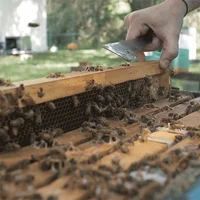Dow
wants to bolster use of a pesticide shown to hurt bees’ reproduction
 Dow
AgroSciences has applied for a large expansion of sulfoxaflor, a pesticide
shown to harm bees, according to a federal notice last week.
Dow
AgroSciences has applied for a large expansion of sulfoxaflor, a pesticide
shown to harm bees, according to a federal notice last week.
The
agricultural chemical company submitted an application to
the U.S. Environmental Protection Agency to allow for use of the pesticide on
rice, avocados, residential ornamentals and at tree farms and greenhouses.
Sulfoxaflor, which attacks the central nervous system of insects, is designed in part to replace "neonicotinoid" pesticides, which multiple studies have linked to bee colony collapse.
Sulfoxaflor, which attacks the central nervous system of insects, is designed in part to replace "neonicotinoid" pesticides, which multiple studies have linked to bee colony collapse.
Research
suggests sulfoxaflor may also harm pollinators. Most recently an August study in Nature linked the
pesticide to reduced bumblebee reproduction.
"Sulfoxaflor-exposed colonies had a 54 percent reduction in the total number of sexual offspring produced compared with control colonies," the authors wrote. "Sulfoxaflor exposure could lead to similar environmental impacts as neonicotinoids if used on crops that attract bees in the absence of evidence-based legislation."
Neonicotinoid
"replacements are just a new method of creating pretty much the same
widespread harm," said Nathan Donley, a senior scientist with the Center
for Biological Diversity, in a statement. "This is not the right way
forward."
The
EPA had previously classified sulfoxaflor "very highly toxic" to
bees. The agency approved the chemical in two brand name pesticides in 2013,
but two years later the U.S. 9th Circuit Court of Appeals overturned the approval because
there wasn't enough evidence that the products were safe for bees.
In 2016 the pesticide was
re-registered but, due to the court ruling, the EPA prohibited
use "on crops attractive to bees before and during bloom" and during
times when bees would be foraging.
In
addition, sulfoxaflor has been used on an estimated 17.5 million acres of
farmland under "emergency exemptions" granted by the EPA over the past
couple years. This practice of granting emergency exemptions for pesticide use
was recently criticized in a U.S. Environmental Protection Agency's Office of
the Inspector General report.
"We
found that the [EPA's Office of Pesticide Programs] does not have outcome
measures in place to determine whether the emergency exemption process protects
human health and the environment," the report stated.
The
EPA will accept comments on Dow's sulfoxaflor application until November 13.